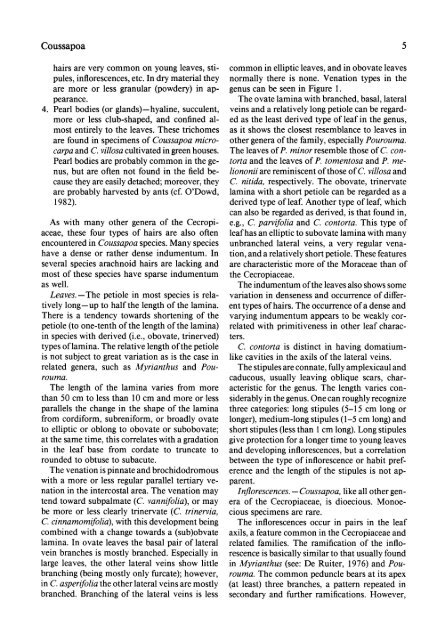Cecropiaceae: Coussapoa and Pourouma, with an ... - CNCFlora
Cecropiaceae: Coussapoa and Pourouma, with an ... - CNCFlora
Cecropiaceae: Coussapoa and Pourouma, with an ... - CNCFlora
Create successful ePaper yourself
Turn your PDF publications into a flip-book with our unique Google optimized e-Paper software.
<strong>Coussapoa</strong><br />
hairs are very common on young leaves, stipules,<br />
inflorescences, etc. In dry material they<br />
are more or less gr<strong>an</strong>ular (powdery) in appear<strong>an</strong>ce.<br />
4. Pearl bodies (or gl<strong><strong>an</strong>d</strong>s)-hyaline, succulent,<br />
more or less club-shaped, <strong><strong>an</strong>d</strong> confined almost<br />
entirely to the leaves. These trichomes<br />
are found in specimens of <strong>Coussapoa</strong> microcarpa<br />
<strong><strong>an</strong>d</strong> C. villosa cultivated in green houses.<br />
Pearl bodies are probably common in the genus,<br />
but are often not found in the field because<br />
they are easily detached; moreover, they<br />
are probably harvested by <strong>an</strong>ts (cf. O'Dowd,<br />
1982).<br />
As <strong>with</strong> m<strong>an</strong>y other genera of the <strong>Cecropiaceae</strong>,<br />
these four types of hairs are also often<br />
encountered in <strong>Coussapoa</strong> species. M<strong>an</strong>y species<br />
have a dense or rather dense indumentum. In<br />
several species arachnoid hairs are lacking <strong><strong>an</strong>d</strong><br />
most of these species have sparse indumentum<br />
as well.<br />
common in elliptic leaves, <strong><strong>an</strong>d</strong> in obovate leaves<br />
normally there is none. Venation types in the<br />
genus c<strong>an</strong> be seen in Figure 1.<br />
The ovate lamina <strong>with</strong> br<strong>an</strong>ched, basal, lateral<br />
veins <strong><strong>an</strong>d</strong> a relatively long petiole c<strong>an</strong> be regarded<br />
as the least derived type of leaf in the genus,<br />
as it shows the closest resembl<strong>an</strong>ce to leaves in<br />
other genera of the family, especially <strong>Pourouma</strong>.<br />
The leaves of P. minor resemble those of C. contorta<br />
<strong><strong>an</strong>d</strong> the leaves of P. tomentosa <strong><strong>an</strong>d</strong> P. meliononii<br />
are reminiscent of those of C. villosa <strong><strong>an</strong>d</strong><br />
C. nitida, respectively. The obovate, trinervate<br />
lamina <strong>with</strong> a short petiole c<strong>an</strong> be regarded as a<br />
derived type of leaf. Another type of leaf, which<br />
c<strong>an</strong> also be regarded as derived, is that found in,<br />
e.g., C. parvifolia <strong><strong>an</strong>d</strong> C. contorta. This type of<br />
leaf has <strong>an</strong> elliptic to subovate lamina <strong>with</strong> m<strong>an</strong>y<br />
unbr<strong>an</strong>ched lateral veins, a very regular venation,<br />
<strong><strong>an</strong>d</strong> a relatively short petiole. These features<br />
are characteristic more of the Moraceae th<strong>an</strong> of<br />
the <strong>Cecropiaceae</strong>.<br />
The indumentum of the leaves also shows some<br />
Leaves. -The petiole in most species is rela- variation in denseness <strong><strong>an</strong>d</strong> occurrence of differtively<br />
long-up to half the length of the lamina. ent types of hairs. The occurrence of a dense <strong><strong>an</strong>d</strong><br />
There is a tendency towards shortening of the varying indumentum appears to be weakly corpetiole<br />
(to one-tenth of the length of the lamina) related <strong>with</strong> primitiveness in other leaf characin<br />
species <strong>with</strong> derived (i.e., obovate, trinerved) ters.<br />
types of lamina. The relative length of the petiole C. contorta is distinct in having domatiumis<br />
not subject to great variation as is the case in like cavities in the axils of the lateral veins.<br />
related genera, such as Myri<strong>an</strong>thus <strong><strong>an</strong>d</strong> Pou- The stipules are connate, fully amplexicaul <strong><strong>an</strong>d</strong><br />
rouma.<br />
caducous, usually leaving oblique scars, char-<br />
The length of the lamina varies from more acteristic for the genus. The length varies conth<strong>an</strong><br />
50 cm to less th<strong>an</strong> 10 cm <strong><strong>an</strong>d</strong> more or less siderably in the genus. One c<strong>an</strong> roughly recognize<br />
parallels the ch<strong>an</strong>ge in the shape of the lamina three categories: long stipules (5-15 cm long or<br />
from cordiform, subreniform, or broadly ovate longer), medium-long stipules (1-5 cm long) <strong><strong>an</strong>d</strong><br />
to elliptic or oblong to obovate or subobovate; short stipules (less th<strong>an</strong> 1 cm long). Long stipules<br />
at the same time, this correlates <strong>with</strong> a gradation give protection for a longer time to young leaves<br />
in the leaf base from cordate to truncate to <strong><strong>an</strong>d</strong> developing inflorescences, but a correlation<br />
rounded to obtuse to subacute.<br />
between the type of inflorescence or habit pref-<br />
The venation is pinnate <strong><strong>an</strong>d</strong> brochidodromous erence <strong><strong>an</strong>d</strong> the length of the stipules is not ap<strong>with</strong><br />
a more or less regular parallel tertiary ve- parent.<br />
nation in the intercostal area. The venation may Inflorescences. - <strong>Coussapoa</strong>, like all other gentend<br />
toward subpalmate (C. v<strong>an</strong>nifolia), or may era of the <strong>Cecropiaceae</strong>, is dioecious. Monoebe<br />
more or less clearly trinervate (C. trinervia, cious specimens are rare.<br />
C. cinnamomifolia), <strong>with</strong> this development being The inflorescences occur in pairs in the leaf<br />
combined <strong>with</strong> a ch<strong>an</strong>ge towards a (sub)obvate axils, a feature common in the <strong>Cecropiaceae</strong> <strong><strong>an</strong>d</strong><br />
lamina. In ovate leaves the basal pair of lateral related families. The ramification of the inflovein<br />
br<strong>an</strong>ches is mostly br<strong>an</strong>ched. Especially in rescence is basically similar to that usually found<br />
large leaves, the other lateral veins show little in Myri<strong>an</strong>thus (see: De Ruiter, 1976) <strong><strong>an</strong>d</strong> Poubr<strong>an</strong>ching<br />
(being mostly only furcate); however, rouma. The common peduncle bears at its apex<br />
in C. asperifolia the other lateral veins are mostly (at least) three br<strong>an</strong>ches, a pattern repeated in<br />
br<strong>an</strong>ched. Br<strong>an</strong>ching of the lateral veins is less secondary <strong><strong>an</strong>d</strong> further ramifications. However,<br />
5
















